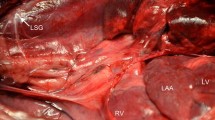Abstract
Since the stellate ganglion contains cardiac sympathetic nerves, stellate ganglion block (SGB) may influence cardiac and coronary hemodynamics. We investigated this influence of SGB by measuring the heart rate (HR), the left circumflex coronary artery blood flow (CBF), the maximum rate of increase of the left ventricular pressure (LV max dP/dt), the cardiac output (CO), the myocardial oxygen consumption (MVO2), and the myocardial oxygen extraction ratio (MOER) in nine dogs before and after performing SGB by means of injection of 2 ml 1% mepivacaine. Left SGB resulted in a decrease of 10% in CBF and a decrease of 15% in LV max dP/dt, but HR, CO, and MVO2 remained unchanged. On the other hand, right SGB resulted in a decrease of 30% in CBF and a decrease of 25% in LV max dP/dt, as well as a decrease of 20% in HR, 15% in CO, and 25% in MVO2. SGB on either side resulted in an increase in MOER that was slight but nonetheless significant (P<0.05) in that it suggested a relative deficit in CBF with respect to MVO2. Inhalation of 100% oxygen decreased MOER to the pre-SGB level in either side, thus improving the myocardial oxygen supply-demand relationship. This study suggests the possibility that SGB has deteriorative effects on the myocardial oxygen supply-demand relationship. Those effects were counteracted by the inhalation of 100% oxygen.
Similar content being viewed by others
References
Bonica JJ (1990) Regional analgesia with local anesthetics. In: Bonica JJ (ed) The management of pain. Lea & Febiger, Philadelphia, PA, London, pp. 1883–1966
White JC (1974) Sympathectomy for relief of pain. Adv Neurol 4:629–638
Klassen GA, Bramwell RS, Bromage PR (1980) Effect of acute sympathectomy by epidural anesthesia on the canine coronary circulation. Anesthesiology 52:8–15
Fukuuchi A, Fujita M, Suzuki H, Kawamata M, Mukubo Y, Yokoyama M (1990) Effects of stellate ganglion block on prevention of variant angina (in Japanese). Pein Kurinikku (Pain Clin) 11:214–218
Randall WC, Rohse WG (1956) The augmenter action of the sympathetic cardiac nerves. Circ Res 4:470–475
Inoue K 1984) Antiarrhythmic effects of stellate ganglion block (in Japanese) Masui (Jpn J Anesthesiol) 33:1187–1195
Tarazi RC, Estafanous FG, Fouad FM (1978) Unilateral stellate block in the treatment of hypertension after coronary bypass surgery. Am J Cardiol 42:1013–1018
Bidwai AV, Rogers CR, Pearce M (1979) Preoperative stellate ganglion blockade to prevent hypertension following coronary artery operations. Anesthesiology 51:345–347
Author information
Authors and Affiliations
About this article
Cite this article
Sasaki, I., Kaneko, T., Iwatsuki, N. et al. Effects of stellate ganglion block on cardiac coronary circulation. J Anesth 9, 338–342 (1995). https://doi.org/10.1007/BF02479948
Received:
Accepted:
Issue Date:
DOI: https://doi.org/10.1007/BF02479948




